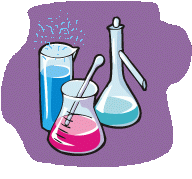


Description of experiment
Below follows a plain text transcript of the selected experiment.
![]()
Needed compounds:
-----------------
potassium chlorate : KClO3
potassium bromate : KBrO3
iodic acid : HIO3
acetic acid : CH3COOH
formic acid : HCOOH
Class:
------
elem=C,Cl,Br,I
redox
Summary:
--------
Formic acid acts as a reductor, while acetic acid does not do so. Formic acid,
however, is not that easily reduced. Reduction requires elevated temperature
and strong oxidizers.
Description:
------------
Add some solid iodic acid to 85% formic acid: The iodic acid does not dissolve
or only a small amount dissolves.
Heat the liquid: Initially nothing seems to happen, but when the formic acid
starts boiling, then the liuqid becomes orange/pink. On further heating, the
color intensifies to a beautiful red/purple and some purple vapor can be
observed.
Add a few drops of water and then heat again: All iodic acid dissolves and the
liquid starts bubbling. When the heat source is taken away, then the liquid
continues bubbling and the color of the liquid becomes darker. Crystals of
sublimed iodine settle on the glass and above the hot liquid there is a purple
vapor. The bubbling of the liquid continues for several minutes. In the
meantime, solid iodine is formed which settles at the bottom of the test tube.
---------------------------------------------------------------
Add some solid potassium bromate to 85% formic acid: The solid does not
dissolve.
Heat the liquid: Soon, the liquid turns pale orange with a reddish hue. On
further heating, bubbles of gas are produced on the solid potassium bromate.
When the heat source is taken away, then the reaction continues. It becomes
more and more violent and in the end it is so violent that a plume of gas is
ekected from the test tube, together with a small amount of bromine vapor.
After the experiment, besides the pungent odor of formic acid, there is a
clearly distinguishable and typical sweet smell of bromin
----------------------------------------------------------------
Add some solid potassium chlorate to 85% formic acid: Part of the solid seems
to dissolve.
Heat the liquid: Fairly quickly, all of the solid has dissolved and a pale
green solution is obtained. On further heating, the color intensifies to a deep
green/yellow and above the liquid there is a yellow/green gas (typical color of
ClO2). At this point the experiment was stopped due to fear of explosion.
Add some water (appr. 2 times the volume of formic acid) and ocntinue heating:
The liquid becomes pale green yellow and a pale green gas can be observed above
the liquid. The chlorate either is reduced to chlorine, or to ClO2 (probably
both reactions occur).
---------------------------------------------------------------
Add some solid iodic acid to glacial acetic acid: The solid does not dissolve.
Heat the liquid until the acid starts boiling: Still, the iodic acid does not
dissolve, nor does the liquid change color. It remains clear and colorless.
Add a few drops of water and continue heating: The water mixes with the liquid
and even when the liquid starts boiling, no color of iodine can be observed and
the iodic acid does not dissolve.
Add a few drops of formic acid and continue heating: Soon, the liquid turns
orange/red. On further heating, this color intensifies.
---------------------------------------------------------------
Add some solid potassium bromate to glacial acetic acid: The solid does not
dissolve.
Heat the liquid, until the acid starts boiling: It looks as if a faint color of
bromine can be observed, but the color does not persist and the solid potassium
bromate does not dissolve. Even after a minute or so of heating, no solid seems
to have dissolved and the liquid still is (almost) colorless.
Add a few drops of water and continue heating: Still, there is no color of
bromine, and the liquid does not react with the potassium bromate. The liquid
slowly boils, but no visible reaction occurs.
Add a few drops of formic acid to the still hot liquid: Within a few seconds,
the liquid becomes yellow/orange and then suddenly a violent reaction starts,
in which a lot of colorless gas is produced. After the reaction, the liquid is
yellow and all potassium bromate has dissolved.
![]()